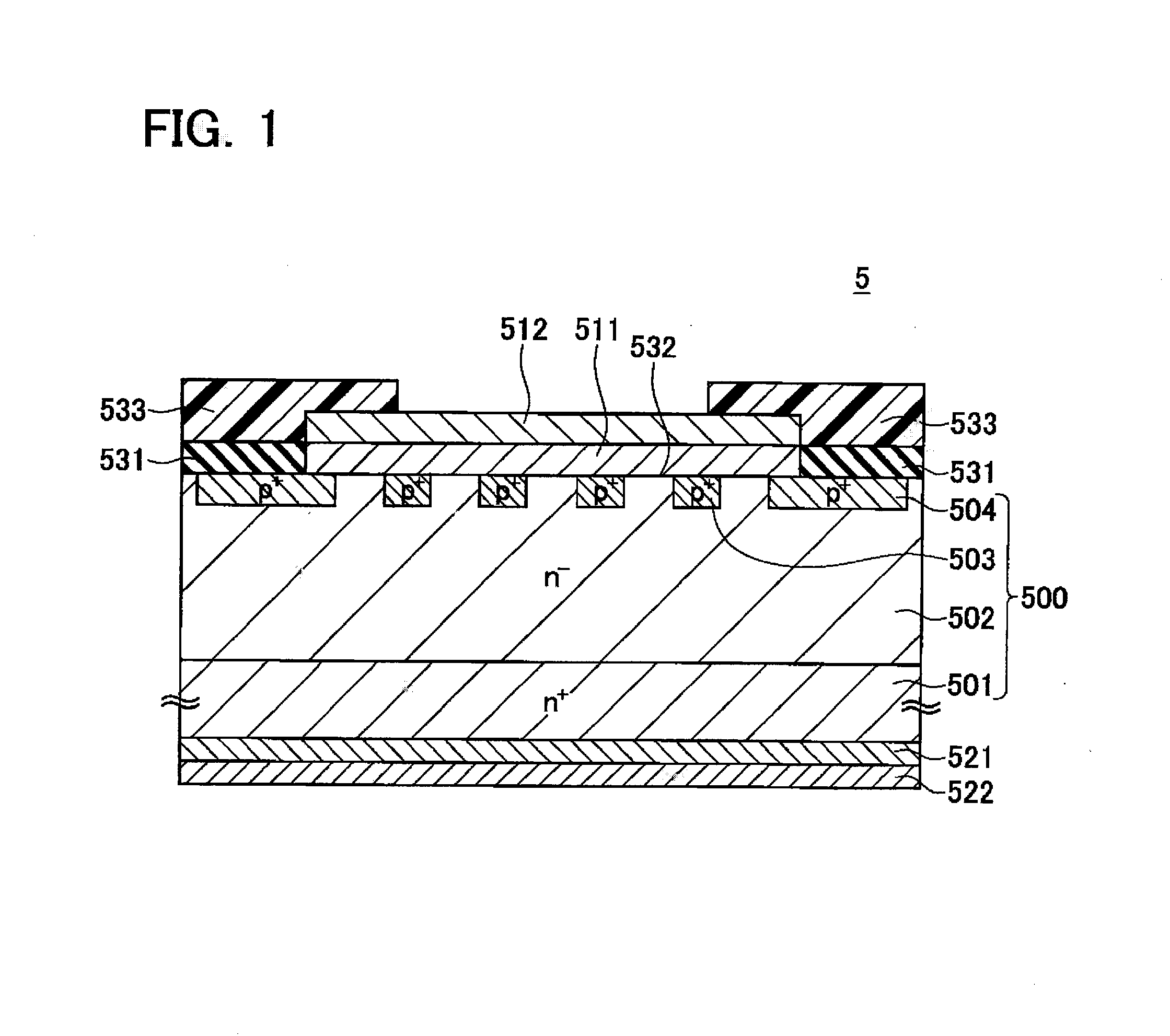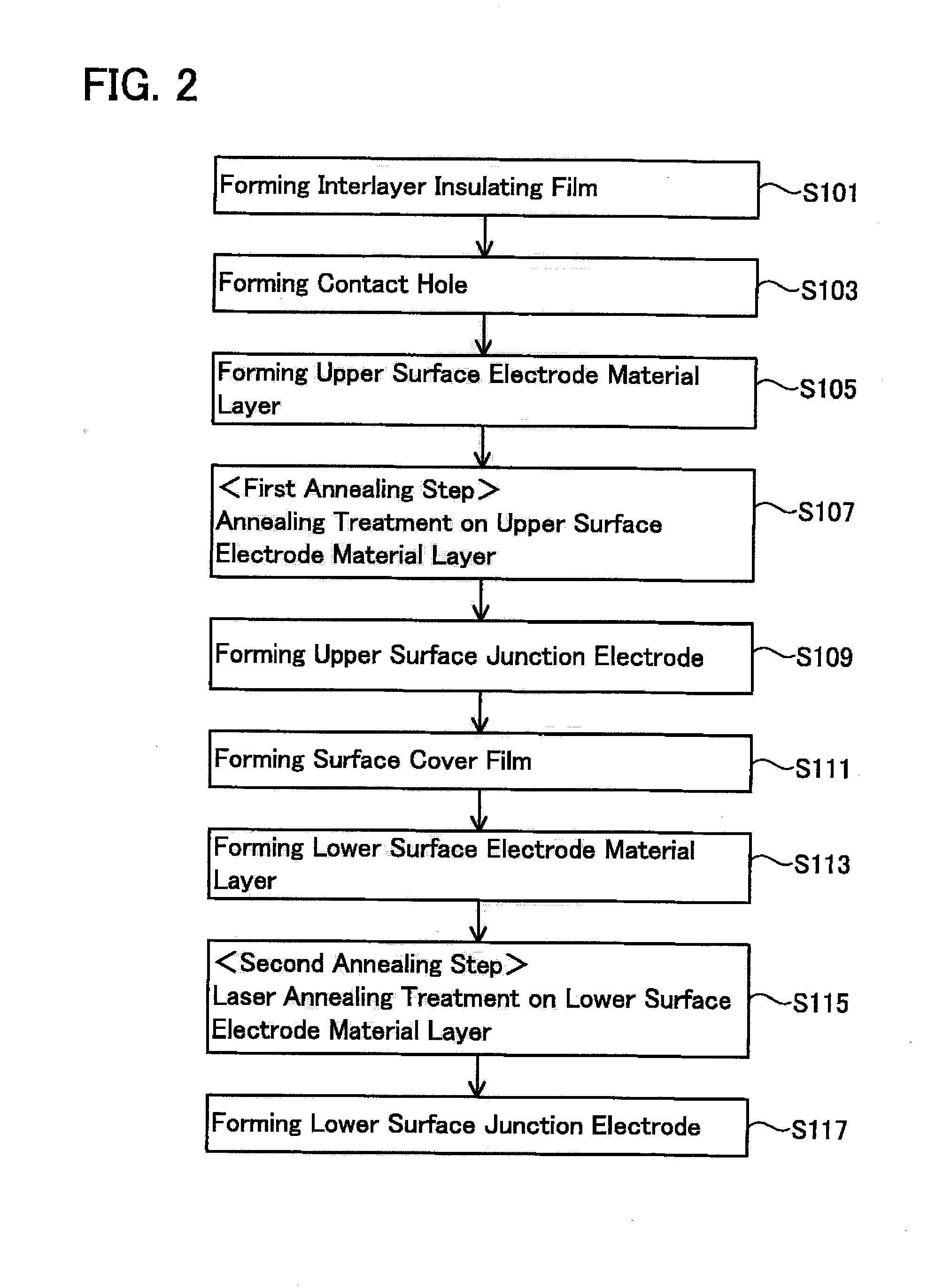Semiconductor device manufacturiing method
- Summary
- Abstract
- Description
- Claims
- Application Information
AI Technical Summary
Benefits of technology
Problems solved by technology
Method used
Image
Examples
first embodiment
[0031]The following provides an explanation of a first embodiment of the present teachings with reference to the drawings. FIG. 1 is a drawing schematically showing a cross-section of a semiconductor device 5 manufactured according to a first manufacturing method relating to the first embodiment. The semiconductor device 5 is a diode having a Junction Barrier Schottky (JBS) structure. A semiconductor substrate 500 is provided with an n-type substrate layer 501 having silicon carbide as a material thereof, an n+-type epitaxial layer 502 laminated on the surface of the substrate layer 501 and having silicon carbide as a material thereof, and a p+-type anode layer 503 and p+-type blocking layer 504 provided on the surface of the epitaxial layer 502. The anode layer 503 is an anode layer having a JBS structure, while the blocking layer 504 employs a Junction Terminal Extension (JTE) structure provided as a peripheral blocking structure.
[0032]An interlayer insulating film 531, an upper s...
example 1
[0075]The following provides a more detailed explanation of an Example 1 that embodies the first embodiment as described above.
[0076](Preparation of Raw Material Wafer)
[0077]An n−-type epitaxial layer (impurity concentration: 5×1015 cm−3, layer thickness: 10 μm) was deposited on the upper surface of a 4H—SiC n+-type semiconductor wafer (impurity concentration: 8×1018 cm−3) having a diameter of 100 mm and thickness of 350 μm. This semiconductor wafer is equivalent to the substrate layer 501 shown in FIG. 1, and this epitaxial layer is equivalent to the epitaxial layer 502 shown in FIG. 1. Moreover, Al ions were injected into the upper surface of the epitaxial layer for forming a p+-type JTE structure, after which Al ions were injected into the upper surface of the epitaxial layer for forming a p+-type JBS structure. Subsequently, annealing was carried out to form the p+-type JTE structure (impurity concentration: 1×1019 cm−3, width: 50 μm, depth: 1 μm) and the p+-type JBS structure (...
second embodiment
[0109]A semiconductor device capable of being manufactured according to the manufacturing method relating to the present teachings may be a semiconductor device having an upper surface electrode in contact with the upper surface of the semiconductor substrate and a lower surface electrode in contact with the lower surface of the semiconductor substrate. An explanation of the second embodiment is provided using as an example a MOSFET shown in FIG. 5 as an example of the semiconductor device alternative to the diode explained in the first embodiment.
[0110]FIG. 5 is a drawing schematically showing a cross-section of a semiconductor device 9 manufactured according to a second manufacturing method relating to the second embodiment. The semiconductor device 9 is a MOSFET. A semiconductor substrate 900 is provided with an n-type drain layer 901, having as a material thereof a semiconductor substrate having silicon carbide as a material thereof, a drift layer 902 laminated on the upper surf...
PUM
| Property | Measurement | Unit |
|---|---|---|
| Temperature | aaaaa | aaaaa |
| Thickness | aaaaa | aaaaa |
| Thickness | aaaaa | aaaaa |
Abstract
Description
Claims
Application Information
 Login to View More
Login to View More - R&D
- Intellectual Property
- Life Sciences
- Materials
- Tech Scout
- Unparalleled Data Quality
- Higher Quality Content
- 60% Fewer Hallucinations
Browse by: Latest US Patents, China's latest patents, Technical Efficacy Thesaurus, Application Domain, Technology Topic, Popular Technical Reports.
© 2025 PatSnap. All rights reserved.Legal|Privacy policy|Modern Slavery Act Transparency Statement|Sitemap|About US| Contact US: help@patsnap.com



